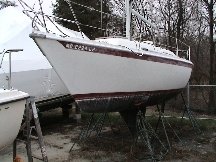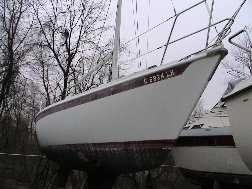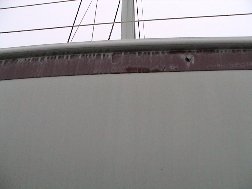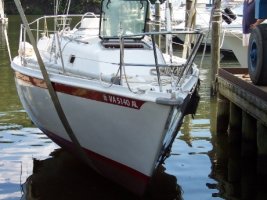Razz
Member I
After owning this boat for 21 years, it's time to apply some major TLC and this is such a wonderful place to learn from your experiences. I'd appreciate any comments and advise you all may offer.
My boat is the 31st hull built in May of 1981. She has been sailed in the Great Lakes and the Chesapeake. Mechanically, the rigging is in tip top shape and the engine works fine. That's where the good news ends. Thankfully there is nothing wrong with the hull, deck and keel that can't be addressed.
Deck: Oxydizing gelcoat and some hairline cracks in the gelcoat. Question: What have you used to seal or refinish the deck?
Rubrail: This is the source of my major complaint about the materials used on this boat. This rubrail oxydizes and chalks excessively. I want to replace it with something that doesn't make such a mess by virtue of it's mere existence. My current thoughts are to replace it with teak or some other ready-made rail. Suggestions?
Hull: Gelcoat is oxydizing and chalky (exaserbated by above rubrail). Burgandy sheer and waterline stripes are virtually pink. I've considered repainting the hull with linear polyurethane paint but I am afraid to make the plunge before consulting with others who have done this. What should this job cost to have a marina do it? Is there any secret to doing a good job except to prepare prepare prepare, follow instructions, take your time and do it right? (Your reading the notes of someone who wet-sanded this boat, put on a VC TAR prepcoat with an airless sprayer that made the bottom look as smooth as an 8-ball, then finished it up with VC-17....now this was a fast bottom!)
Keel: No problems
Rudder: There is a hairline crack that is semi-circular in shape (open towards the leading edge) that has been there since the second year I owned the boat. It doesn't seem to have lessened the strength of the rudder so I believe it to be merely cosmetic and easily repaired. Opinions?
Interior: Ugh....this is the real problem. The scupper in my cockpit plugged with leaves, filled and leaked into the boat around the instrument panel. The bilge filled to 4 inches over the cabin sole. By the time I got there, the damage was done.
Starting at the top, the headliner staples, which were made of iron, all rusted and are in the process of releasing their hold. Ericson materials gripe #2: Why was this "fold-over" plastic trim used to cover the staples which in turn were used to attach the headliner to the teak trim? Why not put up the headliner then the teak trim? I digress....anyway, the whole headliner has to go and I am thinking of putting up teak battens or vinyl again.
The teak plywood along the inside of the deckhouse is delaminating so that has to be replaced...no big deal. The teak plywood used to mate the rosewood & holly sole to the bulkheads and verticals has to be replaced. The rosewood & holly sole might be saved if I sand it and bleach it and, and, and....wouldn't it be easier to just replace it? How do I get it out from under the teak beam that goes from the maststep to the TFG? Take down the mast?
The anchor locker scupper drain hose has disconnected and provides another source of water to the bilge. I've reattached this hose in the past and don't want to do it again because you have to pull the anchor locker. I am going to go through the forwardmost bulkhead by putting a teak door in the bulkhead to gain access to the area under the anchor locker.
Amazingly, the cushions are in reasonably good shape and should come clean. I haven't been into the electrical system but I'll be willing to wager that there are surprises there. BTW, where do I get replacement breakers these days? I'll bet at least one is corroded and no longer functions.
Well, if you have read down to this point, I thank you and hope to hear from you with your ideas and suggestions. I am planning to spend the winter pulling staples and rotten wood while shopping around for replacement parts.
Happy Holidays!
Nick Handres
Ericson 28+ "Rascal"
38 40 06N
77 15 06W
My boat is the 31st hull built in May of 1981. She has been sailed in the Great Lakes and the Chesapeake. Mechanically, the rigging is in tip top shape and the engine works fine. That's where the good news ends. Thankfully there is nothing wrong with the hull, deck and keel that can't be addressed.
Deck: Oxydizing gelcoat and some hairline cracks in the gelcoat. Question: What have you used to seal or refinish the deck?
Rubrail: This is the source of my major complaint about the materials used on this boat. This rubrail oxydizes and chalks excessively. I want to replace it with something that doesn't make such a mess by virtue of it's mere existence. My current thoughts are to replace it with teak or some other ready-made rail. Suggestions?
Hull: Gelcoat is oxydizing and chalky (exaserbated by above rubrail). Burgandy sheer and waterline stripes are virtually pink. I've considered repainting the hull with linear polyurethane paint but I am afraid to make the plunge before consulting with others who have done this. What should this job cost to have a marina do it? Is there any secret to doing a good job except to prepare prepare prepare, follow instructions, take your time and do it right? (Your reading the notes of someone who wet-sanded this boat, put on a VC TAR prepcoat with an airless sprayer that made the bottom look as smooth as an 8-ball, then finished it up with VC-17....now this was a fast bottom!)
Keel: No problems
Rudder: There is a hairline crack that is semi-circular in shape (open towards the leading edge) that has been there since the second year I owned the boat. It doesn't seem to have lessened the strength of the rudder so I believe it to be merely cosmetic and easily repaired. Opinions?
Interior: Ugh....this is the real problem. The scupper in my cockpit plugged with leaves, filled and leaked into the boat around the instrument panel. The bilge filled to 4 inches over the cabin sole. By the time I got there, the damage was done.
Starting at the top, the headliner staples, which were made of iron, all rusted and are in the process of releasing their hold. Ericson materials gripe #2: Why was this "fold-over" plastic trim used to cover the staples which in turn were used to attach the headliner to the teak trim? Why not put up the headliner then the teak trim? I digress....anyway, the whole headliner has to go and I am thinking of putting up teak battens or vinyl again.
The teak plywood along the inside of the deckhouse is delaminating so that has to be replaced...no big deal. The teak plywood used to mate the rosewood & holly sole to the bulkheads and verticals has to be replaced. The rosewood & holly sole might be saved if I sand it and bleach it and, and, and....wouldn't it be easier to just replace it? How do I get it out from under the teak beam that goes from the maststep to the TFG? Take down the mast?
The anchor locker scupper drain hose has disconnected and provides another source of water to the bilge. I've reattached this hose in the past and don't want to do it again because you have to pull the anchor locker. I am going to go through the forwardmost bulkhead by putting a teak door in the bulkhead to gain access to the area under the anchor locker.
Amazingly, the cushions are in reasonably good shape and should come clean. I haven't been into the electrical system but I'll be willing to wager that there are surprises there. BTW, where do I get replacement breakers these days? I'll bet at least one is corroded and no longer functions.
Well, if you have read down to this point, I thank you and hope to hear from you with your ideas and suggestions. I am planning to spend the winter pulling staples and rotten wood while shopping around for replacement parts.
Happy Holidays!
Nick Handres
Ericson 28+ "Rascal"
38 40 06N
77 15 06W





